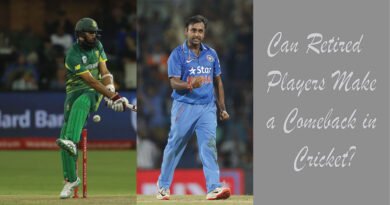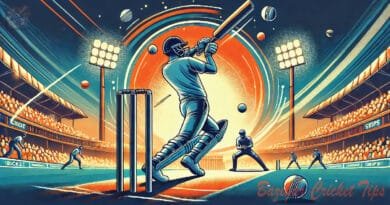How to Read Cricket Scores on TV: A Complete Guide
Cricket is one of the most popular sports in the world, and understanding the live score displayed on TV is essential for following a match. Whether you’re a beginner or a seasoned fan, reading cricket scores correctly helps you stay updated on match progress, player performances, and team standings.
In this guide, we’ll break down how to read cricket scores on TV, explaining each element you see on the scoreboard, including runs, wickets, overs, strike rates, and more.
Table of Contents
Toggle1. Understanding the Basic Cricket Score Format
When watching a cricket match on TV, you will typically see the score displayed in this format:
Team A: 250/5 (40.2 overs)
Here’s what each part means:
- 250 → Total runs scored by the batting team.
- 5 → Number of wickets lost.
- 40.2 overs → Overs bowled (40 full overs and 2 balls from the next over).
The scorecard gives an instant summary of the match status.
2. Key Elements in a Cricket Scoreboard
A. Team Score & Wickets
This is the most important part of the scoreboard. It shows the runs scored and wickets fallen for the team currently batting.
Example:
India: 189/4 (32.3 overs)
- India has scored 189 runs.
- They have lost 4 wickets.
- They have played 32 full overs and 3 balls of the next over.
B. Overs (O)
An over consists of 6 legal deliveries bowled by a bowler. The overs count helps track how much of the match has been completed.
Example:
Overs: 15.4
This means 15 full overs have been bowled, plus 4 extra deliveries in the 16th over.
C. Run Rate (RR)
The run rate indicates how fast a team is scoring. It is calculated as:
Run Rate = Total Runs Scored / Total Overs Bowled
If a team has scored 150 runs in 25 overs, the run rate is:
150 ÷ 25 = 6.0 runs per over
D. Required Run Rate (RRR)
In a chase, the required run rate shows how many runs the batting team needs per over to win.
Example:
Required Run Rate: 8.5 RPO
This means the team needs 8.5 runs per over to reach the target in the remaining overs.
E. Current Batsmen’s Stats
On the scoreboard, you will see the two current batsmen and their performance.
- Batsman 1: Rohit Sharma 65*(48)
- Batsman 2: Virat Kohli 32(28)
- 65* → Runs scored (an asterisk * means the batsman is not out)
- 48 → Balls faced
- 32(28) → Second batsman’s score: 32 runs off 28 balls.
F. Bowler’s Stats
The scoreboard also shows details of the current bowler.
Bowler: Pat Cummins 6-1-29-2
- 6 overs bowled
- 1 maiden over (an over where no runs were conceded)
- 29 runs conceded
- 2 wickets taken
3. Additional Scoreboard Information
Apart from the main score, you will also see:
- Fall of Wickets (FOW) → Shows when wickets fell.
- Extras (X) → Includes wides, no-balls, byes, leg byes, and penalty runs.
- Partnership Runs → The number of runs scored by the two current batsmen.
- Target (T) → If the second team is batting, the required target will be displayed.
- Win Probability % → Some broadcasts include a projected win percentage for both teams based on historical data.
4. Understanding T20, ODI, and Test Match Scoreboards
A. T20 Match Scoreboard
A T20 scoreboard usually includes:
- Team score (e.g., 180/6 in 17.3 overs)
- Strike Rate (SR) → Shows how quickly a batsman is scoring (Runs per 100 balls)
- Economy Rate (Econ) → Bowler’s runs conceded per over
B. ODI Match Scoreboard
An ODI scoreboard has similar stats but also includes:
- Duckworth-Lewis-Stern (DLS) Method → Used in rain-affected matches to calculate a revised target.
C. Test Match Scoreboard
- Match Progress → Shows how many innings each team has played.
- Lead → Indicates if one team is ahead based on runs.
- Declaration → If the batting team ends their innings voluntarily.
- Follow-On → If a team scores significantly fewer runs than the opposition, they may be forced to bat again.
5. Live Score Graphics & Symbols on TV
When watching cricket on TV, you’ll notice different graphics and symbols:
| Symbol | Meaning |
|---|---|
| * | Batsman is not out |
| 4 | Boundary (Four runs) |
| 6 | Six runs hit by the batsman |
| W | Wicket lost |
| X | Extra runs (wides, no-balls, etc.) |
| RRR | Required Run Rate |
| NRR | Net Run Rate (important for tournament rankings) |
6. Tips for Reading Cricket Scores Quickly
- Focus on the score summary first (Runs/Wickets/Overs).
- Check run rate and required run rate to understand match progress.
- Look at individual performances (batsmen and bowlers).
- Note the fall of wickets – it affects the game’s momentum.
- Understand team strategies based on the scoreboard (aggressive vs. defensive play).
Conclusion
Reading cricket scores on TV becomes easy once you understand the basic format, key statistics, and symbols used in the scoreboard. Whether you’re watching a Test, ODI, or T20 match, this guide will help you analyze team performances and enjoy the game more deeply.
Next time you tune into a match, try reading the score like an expert and impress your friends with your cricket knowledge!
Would you like more cricket tips? Drop a comment below! 🏏
You can also check New Zealand vs Pakistan 5th T20—Live Streaming




